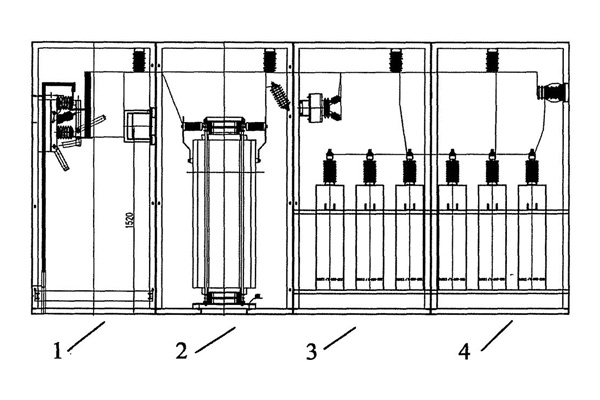your location : Home
> Weidy Express > Weidy Monthly > Weidy October Monthly >
Function introduction of different power capacitors
2021-08-12 15:17:00
What are the functions of power capacitors? Weidi Industrial Professional Capacitor Factory will take you to understand:
First, the function of the series capacitor.
1) Increase the voltage at the end of the line. The capacitor connected in series in the line uses its capacitive reactance xc to compensate the inductive reactance xl of the line to reduce the voltage of the line, thereby increasing the voltage at the end of the line (the receiving end). Generally speaking, the voltage at the end of the line can be increased by 10% to 20%.
2) Reduce voltage fluctuations at the receiving end. Series capacitors can eliminate sharp fluctuations in voltage, because the compensation effect of series capacitors on the line for voltage drop varies with the load of the capacitor, and the compensation effect of series capacitors on the line for voltage drops varies with the load of the capacitor , with the performance of instantaneous adjustment as the load changes, and can automatically maintain the voltage value at the load end (power receiving end).
3) Improve the power transmission capacity of the line. Due to the compensation reactance xc of the capacitor in series with the line, the voltage drop and power loss of the line are reduced, and the transmission capacity of the line is increased accordingly.
4) Improved trend distribution of the system. Some capacitors are connected in series on some lines of the closed network, which partially changes the line reactance and makes the current flow according to the specified line, so as to realize the economical distribution of power.
5) Improve system stability. After the line is connected with the capacitor in series, the power transmission capacity of the line is improved, and the static stability of the system is improved. When the line fault is partially removed (for example, the double circuit is cut once, but the single phase of the circuit is cut off one phase), the equivalent reactance of the system increases sharply. At this time, the series capacitors will be compulsorily compensated, that is, the number of capacitors connected in series and in parallel will be changed in a short period of time, the capacitive reactance xc will be temporarily increased, the total equivalent reactance of the system will be reduced, and the transmission limit power will be increased (Pmax=U1U2/xl-xc), thus Improve the dynamic stability of the system.
 Second, the role of parallel capacitors.
Second, the role of parallel capacitors.
First, the function of the series capacitor.
1) Increase the voltage at the end of the line. The capacitor connected in series in the line uses its capacitive reactance xc to compensate the inductive reactance xl of the line to reduce the voltage of the line, thereby increasing the voltage at the end of the line (the receiving end). Generally speaking, the voltage at the end of the line can be increased by 10% to 20%.
2) Reduce voltage fluctuations at the receiving end. Series capacitors can eliminate sharp fluctuations in voltage, because the compensation effect of series capacitors on the line for voltage drop varies with the load of the capacitor, and the compensation effect of series capacitors on the line for voltage drops varies with the load of the capacitor , with the performance of instantaneous adjustment as the load changes, and can automatically maintain the voltage value at the load end (power receiving end).
3) Improve the power transmission capacity of the line. Due to the compensation reactance xc of the capacitor in series with the line, the voltage drop and power loss of the line are reduced, and the transmission capacity of the line is increased accordingly.
4) Improved trend distribution of the system. Some capacitors are connected in series on some lines of the closed network, which partially changes the line reactance and makes the current flow according to the specified line, so as to realize the economical distribution of power.
5) Improve system stability. After the line is connected with the capacitor in series, the power transmission capacity of the line is improved, and the static stability of the system is improved. When the line fault is partially removed (for example, the double circuit is cut once, but the single phase of the circuit is cut off one phase), the equivalent reactance of the system increases sharply. At this time, the series capacitors will be compulsorily compensated, that is, the number of capacitors connected in series and in parallel will be changed in a short period of time, the capacitive reactance xc will be temporarily increased, the total equivalent reactance of the system will be reduced, and the transmission limit power will be increased (Pmax=U1U2/xl-xc), thus Improve the dynamic stability of the system.

Shunt capacitors are connected in parallel on the system bus, which is similar to a capacitive load on the system bus. It absorbs the capacitive reactive power of the system, which is equivalent to sending inductive reactive power to the system from parallel capacitors. Therefore, the shunt capacitor can provide the system with inductive reactive power, the power factor of the system operation, and increase the voltage level of the busbar at the receiving end. At the same time, it reduces the transmission of inductive reactive power on the line, reduces voltage and power loss, and thus improves the transmission capacity of the line.
 INDUSTRLAL electronic
INDUSTRLAL electronic



 Scan code 5 seconds
Scan code 5 seconds